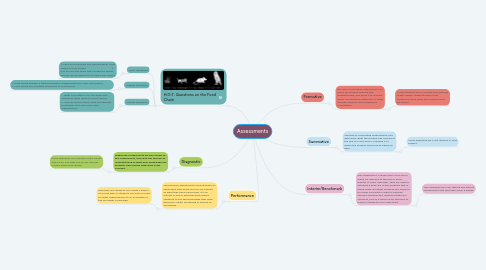
1. Performance
1.1. Performance assessments allow students to show what they know and can do instead of what they have memorized. It is an activity or set of activities that require students to use the knowledge they have gained to create something or should us something.
1.1.1. Examples are students can create a poster of a food web or students can write a script for what might happen to an ecosystem if the food web is changed.
2. Diagnostic
2.1. Diagnostic Assessments are also known as pre-assessments, they give the teacher an understanding of what prior knowledge the students have before beginning a new concept.
2.1.1. Some examples are a google forms survey and a KWL and they can fill out the first column before the lesson.
3. H.O.T. Questions on the Food Chain
3.1. Open Questions
3.1.1. 1. Can you recall what you learned about food chains in third grade? 2. Can you list the three new vocabulary words that we will be adding to our word wall today?
3.2. Guiding Questions
3.2.1. 1. What would happen if the top predator disappeared from their food chain? 2. How would you compare producers to consumers?
3.3. Closing Questions
3.3.1. 1. What conclusions can you draw from looking at these different food chains? 2. How would you apply what you learned to develop your own food chain presentation?
4. Formative
4.1. The goal of formative assessment is to check for student learning and understanding, and using it to actively adjust and improve instruction. It helps teachers address misconceptions immediately.
4.1.1. A few examples are a concept map and exit tickets where students write a few sentences about what they learned from the lesson.
5. Interim/Benchmark
5.1. This assessment is given every once and a while, for example at the end of every quarter or every semester. They are used to establish a base line of the progress that is being made and what progress still needs to be made. This data is used to measure student achievement, identify patterns in students, and as a resource for teachers to instruct students more effectively.
5.1.1. Two examples are MAP testing and district assessments that are taken every 6 weeks.
6. Summative
6.1. The goal of summative assessments is to determine what the student has learned at the end of a unit and to compare it to where the student should be at based on data.
6.1.1. Some examples are a unit quizzes or final project.

